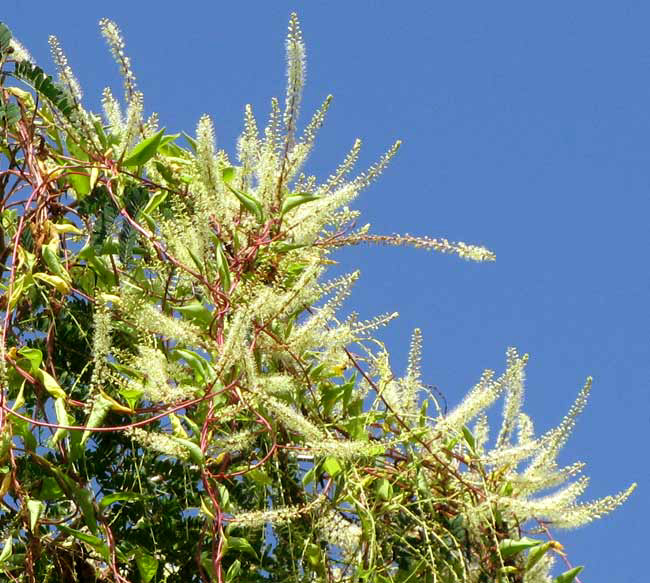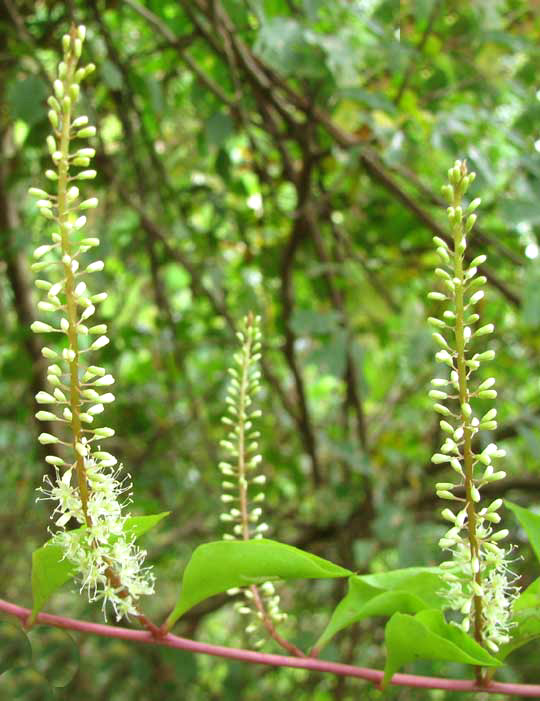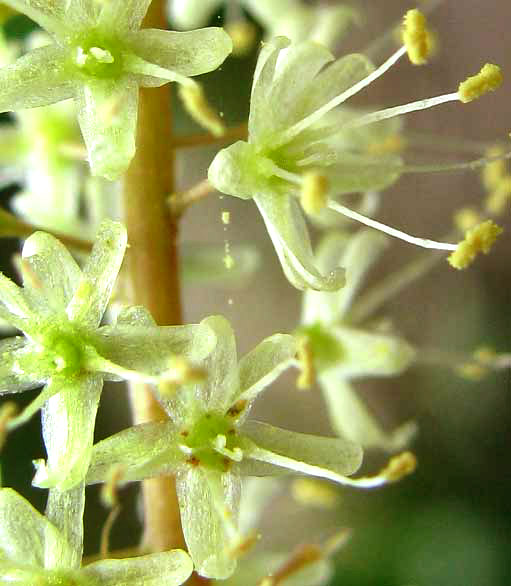Excerpts from Jim Conrad's
Naturalist Newsletter

from the October 31, 2010 Newsletter issued from Hacienda Chichen Resort beside Chichén Itzá Ruins, central Yucatán, MÉXICO; limestone bedrock, elevation ~39m (~128ft), ~N20.676°, ~W88.569°
ABUNDANT UNORTHODOX VINE
Nowadays a very common vine crowning the tops of tall trees is issuing slender racemes of tiny, white flowers. You can see some racemes about 20 feet up at the top of this page. A close-up of racemes arising from their pink stem is shown below:

A close-up of some flowers appears below:

Thing is, I've never seen anything quite like this. Most of the time I can at least recognize a plant's family, but this time at first glance I drew a blank. The blossoms look like they're six-parted, which would indicate that they're monocots, and in fact the flowers look a bit like hyacinth flowers, but the leaves are net-veined, while the vast majority of monocotyledonous species are parallel-veined, like the leaves of grass.
I had to bring that last flower picture onto my laptop's screen before seeing what makes the flowers unusual. First of all, instead of the blossoms bearing six cream-colored petals, they had the usual five, but a sepal was cream-colored camouflaged to look like a sixth petal. Most flowers with five petals have five calyx lobes, or sepals, while this one only had two. It took a bit of studying before I understood that while one sepal was wedged between the top two petals looking like a petal, the other sepal was hidden exactly beneath and flush with the bottom petal. In the last close-up, on the flower at the upper right, you can see what this looks like. One final curiosity is that the five stamens each arise opposite a petal, instead of alternating with it, which is the more common arrangement.
Once the flowers' atypical anatomy was grasped it was easy to key out the family using my old Bailey's Manual of Cultivated Plants. It was a family I'd not run into before, the Basella Family, the Basellaceae, a small, mostly Tropical American family in which most species are climbing, perennial, fleshy herbs -- like ours.
Our plant is ANREDERA VESICARIA, found from southern Texas and southern Florida south through most of tropical America, plus in much of the rest of the world's tropics it's invading as a weed. Often it's planted for its showy inflorescences and fragrant flowers, the odor reminding me of cut hay. The species specializes in disturbed habitats, so here's one species poised to proliferate and expand its distribution as the planet warms and ecosystems are further torn apart.
There's no commonly accepted English name for Anredera vesicaria, though species in the genus Anredera often are referred to as Madiera Vines.
Another curious thing about this species and other members of Anredera is that its flowers present themselves in two morphologically distinct forms. All flowers in both forms bear both male and female parts, but there's a "functionally male" form in which the stamens are a little larger and there's less likelihood of the flowers producing fruits, and then there's a "functionally female" form, with smaller stamens, and a much greater likelihood of producing fruits. The impression is given of a species in the process of evolving into a dioecious state -- with completely male or completely female plants. I assume that I've photographed a functional male.
Both forms produce subterranean tubers, which José tells me are too hard to be edible.
The online Flora of North America says that in Mexico the species has been used to treat broken bones and flesh wounds.
Luis tells me that in Maya the vine is called Baax and that it's used against "bad winds," which afflict us with all kinds of aches and pains, and the evil eye.
We've encountered so many plants used by the Maya this same way that one gets the impression that folks here are uncommonly plagued by "bad winds" and evil eyes. I can only guess why Anredera vesicaria has gained a reputation as an antidote. Somehow it just seems that the vines' slender, sunlight-charged spikes of white flowers crowning treetops are about the opposite of the formless, dark, heavy, depressing aspect of undefined aches and general bad luck.